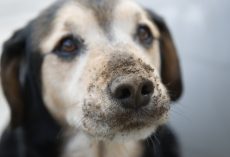It seems a little morbid to talk about pet death but at some point, it's something we all have to face. Would you preserve your pooch?
The most important question we face after a pet has died is “What will happen to the body?” Even for those who are unsentimental about dead animals, there are reasons why disposition—or, to put it more crudely—disposal-of the carcass matters.
Taxidermy and Freeze-Drying
Taxidermy produces a three-dimensional replica of an animal. Sometimes the actual skin of the animal is mounted on some kind of frame; sometimes the animal is reproduced using nothing but man-made materials. Not surprisingly, the preserved animals tend to look stuffed.
A more life-like option has become available, and appears to be replacing taxidermy as the preferred preservation method: freeze-drying. This allows pet owners to see, touch and hold their pets, and in a sense, “never have to let go.”To freeze-dry an animal, you place it in a sealed vacuum chamber at very low temperature. Over time, frozen moisture is converted into a gas and then extracted. By removing the moisture, you stop the process of decay. The drying takes considerable time.
Cryonics
Although cryonics and freeze drying both involve extreme cold, they differ in important respects, both technical and philosophical. The Cryonics Institute explains:
Cryonics is a technique designed to save lives and greatly extend lifespan. It involves cooling legally-dead people to liquid nitrogen temperature where physical decay essentially stops, in the hope that future technologically advanced scientific procedures will someday be able to revive them and restore them to youth and good health. A person held in such a state is said to be a “cryopreserved patient”, because we do not regard the cryopreserved person as being really “dead.”
If you cryogenically preserve your pet, you will not have the pleasure of its company in your house; the body must remain suspended in a tank of liquid nitrogen at the cryonics facility at a carefully controlled temperature of -196° Celsius. But you can live with the hope that someday you could have your actual pet again—or an exact clone of your pet—once science has progressed enough that we can reanimate frozen bodies, or somehow upload animal souls into a brave new cyber-universe.
All of these techniques of preservation were pretty interesting to read. Although pet taxidermy doesn't seem like a common thing, there are a lot of people that want to keep their doggies with them after they're dead. What would you do?
For more information on pet preservation, visit Psychology Today.











Vickie Pickett Ewing
- Edit
Yes. Let them RIP
Lauren LS
- Edit
Gayle Lim
Barbara Steele
- Edit
I don’t have a problem with people who want this, but i could never do it. I want the memories of them alive and playing, puppy kisses, soft ears to rub, steady breathing when napping beside you. If you stuff them then all you see is that and that makes me feel sad, ruins my good memories.
Vickie Pickett Ewing
- Edit
Agree
Pamela Oprea Yenglin
- Edit
Yes it is!
Charlotte Jane
- Edit
Unless your name is Norman Bates!
Pug Fans Society
- Edit
anyone love this post as much as me
Roy Perrine
- Edit
Nope, can’t do that!
Lisa McEwen
- Edit
Why would you want to see your poor dead stuffed pup everyday?! I can’t imagine anything more depressing
Debbie Outhouse
- Edit
Yes, I think a picture is enough